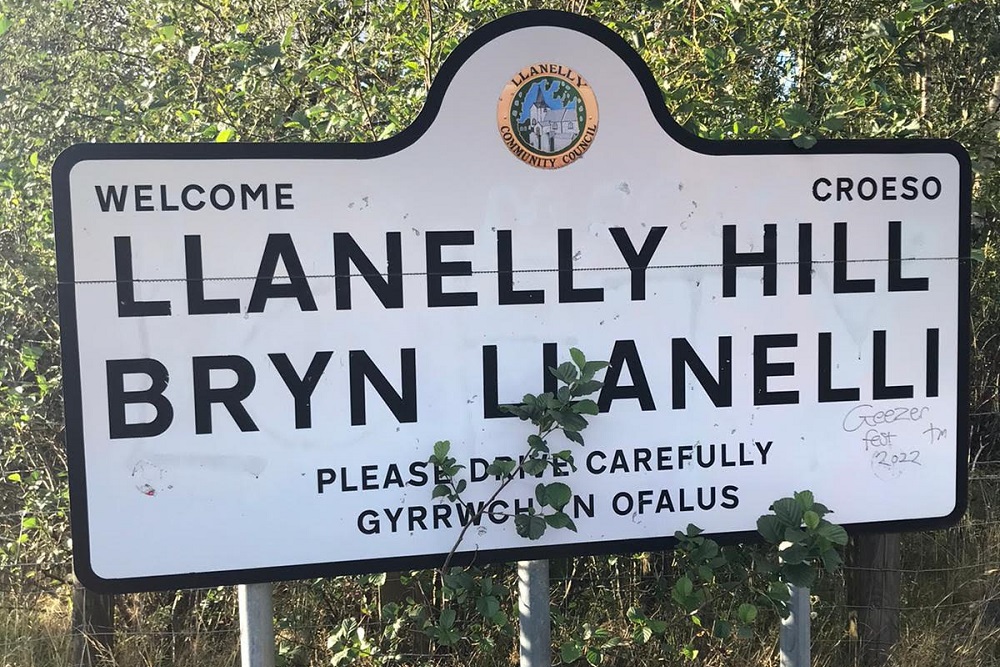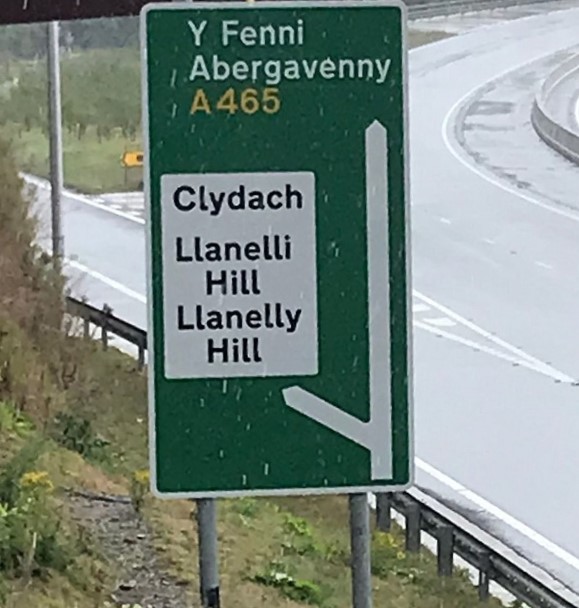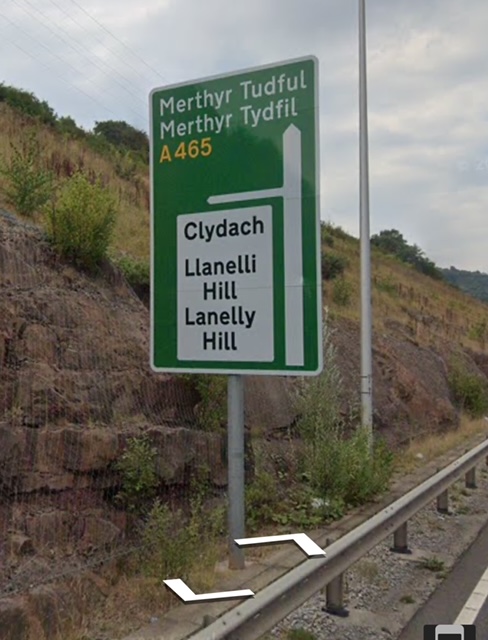Revisited and Updated: The village that lost its Welsh name overnight

Stephen Price (Article first published 9 April 2023)
Back in January 2015, with the Heads of the Valleys Road widening in full swing, few communities were hit so hard as the two small Monmouthshire villages of Clydach and Llanelly Hill.
Caught in the middle, we found ourselves landlocked, polluted by noise and diverted traffic, and witnessed the irreplaceable loss of native beech woodland in a supposed site of special scientific interest in a forgotten corner of the Brecon Beacons.
The scheme overran in both time and millions upon millions of pounds, and has resulted in the life-enhancing impact of an extra lane that is rarely used just in case drivers break the rather bizarre 50mph speed limit.
One change, however, might seem insignificant to anyone but a few remaining locals, but for those who care about the importance of our history and place names, has the power to anger and upset on a cellular level.
Namely, the proactive loss of the Welsh name for Llanelly Hill – Rhiw Llanelli (or Llanelly based on the localised historic spelling from before the standardisation of the Welsh alphabet).
Growing up, attending one of the two local primary schools which have long since closed in the name of progress, the name Rhiw Llanelli was the one and only name for Llanelly Hill in conversation with the handful of local Welsh speakers, in Welsh classes at school, in official Welsh translations, on all signage and on our council tax letters.
Overnight, however, the name was binned in favour of the Google Translate-friendly ‘Bryn Llanelli’. New signs were erected on both entry points to the village declaring the new name Bryn Llanelli in conjunction with the A465 dualling. And that was that.
Preserved
The original name is thankfully preserved in road names (Rhiwr Road) and house names, (Troed y Rhiw, Ty Rhiw, Pen Rhiw Cottage).
The word Rhiw can mean slope, or side of the hill, which more accurately describes this cluster of smaller villages clinging to the side of a rather spectacular gorge – it’s not the entire hill, as Bryn would suggest.
Besides being utterly beautiful, the Welsh language is also pinpoint accurate when referring to place names, and these names matter.
The old gravestones, fast decaying, speak of a different Clydach and Llanelly Hill – yr hen iaith fy nhadau being the language of the soil and our ancestors, and many of us today, myself included, have claimed it back and care. Deeply.

Within days of the erection of a new sign for my beloved Rhiw Llanelly (or should I now say, Bryn Llanelli), those of us who had grown up in the area were quite rightly outraged, and whilst most of the outrage ineffectually took place on the local Facebook village group, a few of us contacted Monmouthshire County Council and demanded to know how a place name can be changed overnight with absolutely no local input.
In my case, I backed up my complaint with photos, old documents, anecdotes and historical knowledge. Rather naively, I expected a swift response. Would people in Abertawe, Caerdydd, Aberteifi etc. be happy to wake up with a new name for the place they call home? I gladly think not. So why is this acceptable?
Cue emails back and forth for a while, and an idle threat to contact the Abergavenny Chronicle (horror of horrors!) the correct course of action was not (as I thought) to reinstate the original name of Rhiw Llanelli, or to go with the updated reductive Bryn Llanelli, but to follow the Welsh Language Commissioner’s advice that the Welsh name is to be… drum roll…. Llanelli Hill.

Laughable
Drivers are now treated to a laughable sign telling them that they are passing by ‘Llanelly Hill : Llanelli Hill’. You read that right – the Welsh for Llanelly Hill is now Llanelli Hill – pronounce that final Ll as you wish. If only we had a word (or multiple words) for hill in Welsh!
Last year, I tried one last time to make the council and those responsible for the signage (the Welsh Government) see sense, but their hands are tied by the decisions of the Welsh Language Commissioner. Again, I also contacted the Welsh Language Commissioner to try to undo this complete disregard and idiocy and to hopefully have an ally.
The council has rather unsurprisingly gone quiet, but the all-powerful Commissioner did get back to me in November of last year, and I was told that my ‘complaint is valid and meets the requirements of section 93 of the Welsh Language (Wales) Measure 2011.
This means that the complaint included sufficient details for me to consider it further’.
‘Standards do not apply’
Needless to say, my heart leapt and I thought that finally something might be done, but the Commissioner’s word salad continued to inform me that ‘the sign was installed in 2015, before the Welsh language standards came into force. Since the sign was installed before the organisation became subject to Welsh language standards, the standards do not apply’.
So, the sign is acceptable because of a technicality. A village can have a new name because of the decisions of outsiders, and a road sign can remain untouched because of a technicality.

Monmouthshire County Council refer to the village as Rhiw Llanelli in only their council tax documents nowadays because, seemingly, no one can be bothered to change it, but elsewhere Google translate users in their offices (or possibly human translators with limited Welsh vocabulary and even less local knowledge) continue to declare the village Bryn Llanelli, as do outside organisations and incoming residents and, again, that’s fine.
Unfortunately for me, however, I don’t think it’s fine.
It grieves me to know how easily this important, evocative and accurate name has been lost, and what it represents on a wider level.
And not only how little it matters to the people whose job it should be to care, but how ineffectual my attempts to be listened to have been. But that’s fine. I should just let it go.
Update December 2023
After writing this post back in April 2023 and (mostly) receiving encouraging feedback, I decided to give one last shot to getting both Monmouthshire Council, the Welsh Gov (responsible for the A465 signage) and Traffic Wales to see even a little sense on this subject. I even suggested just going with the new name for it to at least appear logical.
I must add that the person who I dealt with at the Council at the time the signs were first erected, who has since retired, is a passionate Welsh speaker himself, and it was not his decision to amend the signage in any way, and was on my side at the time, and he relayed my concerns to all the right places at the time – the new name came from the Welsh Language Commissioner, the Bryn Llanelli sign came from the Community Council.

Before I share my updates, I also spotted yet another incorrect sign for the village recently. This time, on the approach to Clydach from the A465 calling it ‘Lanelly Hill’. Add that to Bryn Llanelli, Llanelli Hill and Llanelly Hill and subtract Rhiw Llanelli and we have… something. Not sure what.
Anyway, over to my responses…
Firstly, I contacted Traffic Wales regarding the unofficial ‘Bryn Llanelli’ signage and was told “as this matter relates to a location off the Welsh Government’s strategic road network, the matter will need to be investigated by the Local Authority in this area.”
I then took my concerns to the council yet again, writing:
“Hopefully this will be the last email from me (hurrah!) until some resolution is found but Traffic Wales confirm that the community council erected sign off the B4248 is for the local authority to investigate and amend.
This was erected by the community council and needs to be taken down as it was never authorised. I imagine nothing will be done but there’s always hope!”
To this date, I have not received a response from Monmouthshire County Council.
The Welsh Government are responsible for the A465 signage.
Some three months after I tried again to get a resolution, I received this response from the Welsh Gov:
“The Welsh Government and its Ministers are the Highway Authority responsible for the Motorway and Trunk Road Network in Wales and its associated assets. The A465 is a Trunk Road.
Please accept our apologies for the delay in responding.
The Welsh Language Commissioner confirms both the Welsh and English versions of the place name as Llanelli Hill.
Please note that you will need to contact Monmouthshire County Council to discuss the Community Council sign as this is a matter for them to address. The Welsh Government will amend the signs on the A465 Trunk Road once funding allows and on receipt of the Council’s signage recommendation.”
The Welsh Government can’t afford road signage? Funny that… And they require council signage recommendation just to add another level of bureaucracy/to ensure nothing is ever done.
So in conclusion – no one gives a toss. Why should they? They’re not from the area. They get paid the same amount every month whatever they do or don’t do.
A very interesting reply to the piece came from Dylan Foster Evans at the time, however. He shed some interesting light on the ‘Bryn Llanelli’ coinage, and even that of ‘Rhiw Llanelli’ as I grew up with, writing: “I wonder how old ‘Rhiw Llanelli’ is? Welsh-language sources from the 19th and early 20th century have ‘Mynydd Llanelli’, as here (in the context of the miners’ lodge) and here (with reference to the Baptist chapel).”
Llanelly Hill itself is a wider name for a cluster of smaller villages – Cwm Nant Gam, Gellifelin, Waenllapria, Daren Felin to name but a few, all swallowed up in the wider name of Llanelly Hill.
With the large town of Brynmawr immediately next door, too, Bryn felt like even more of a clunk, even more of a decision made by someone with no local knowledge or care.
I personally quite like ‘Mynydd Llanelli’ – like Rhiw, and unlike Bryn, it has real historical context, it wasn’t decided via Google Translate.
Many readers also shared their experiences at the time too (Trelech, Tryleg and Trellech for example) so this is not an isolated case. ‘Pick a name, any name!’
And others shared similar experiences of hitting a brick wall or being made to feel petty for trying to get some sense (and respect for the Welsh language and our smaller village communities) from the powers that be.
As I said back in April – it matters. It really does.
Support our Nation today
For the price of a cup of coffee a month you can help us create an independent, not-for-profit, national news service for the people of Wales, by the people of Wales.





Well done for keeping up the fight against these anti Welsh robots 👍🏼
I take it you mean the Welsh Language Commissioner for it is they who insist on Llanelli Hill.
Google translate is hopeless. Try looking up swallow in their Welsh dictionary. I pointed out to Tredegar House that Ty Tredegar was inappropriate and it should be neuadd or Plas in Welsh. The same problem of loss of language precision occurs in English too. A new development on Pits Heath here in Halton in Cheshire is called Pitts Heath. The area was full of pits where sand and clay had been extracted. I suppose the developers couldn’t call it The Pits. Synthetic names sounding rural are even worse and often bear no relation to the locality. Words like Croft and… Read more »
An interesting piece. I don’t know which is worse – the Slavish ‘Bryn’ translation, or ‘Llanelli Hill’ as the Welsh name …
I wonder about ‘Rhiw Llanelli’, though, which sounds like it might also be a ‘standard’ Welsh translation, as most of the south east uses a form of tyllau / tyle / tyla where standard Welsh uses rhiw. Mynydd Llanelli is perfect, with the meaning of uplands.
Strange that the Commissioner’s office was willing to cause all sorts of problems with Varteg / Gartref a few years back, but doesn’t see an issue with Llanelli Hill…
I’m usually really happy with the Welsh AutoCorrect on my Google keyboard.
But just to make sense of my previous comment: tylau, not tyllau, and Farteg, not Gartref.
Don’t employ my proofreading service…
Thank you for a very interesting article. It set me to thinking about another village, Laugharne, which sometime in the 1970’s I think, metamorphosed from “Lacharn” to “Talacharn” on signage.
A little googling led me to a website https://historicplacenames.rcahmw.gov.uk/placenames/recordedname/
which is a fount of knowledge, but unfortunately not much help as far as the specific issue you raise.
I would sign a petition for Rhiw Llanelli.
Personally, I say ban English names on Welsh road signs.
Some Welsh names are nonsense though; Wrecsam, Fflint, Biwmares for example are just transliterations. Prestatyn looks superficially OK but is totally meaningless in Welsh, it’s just the middle English name transliterated, it’s like Yr Wyddfa being named Snodyn. Also nobody can agree on some of the Welsh where local dialect comes in; Cader, not Cadair, Idris for example. Rhiw Llannelly, not Llannelli, would be correct here.
Ultimately unless the majority of people in Cardiff, Swansea, Newport and so many other places want to prioritise Welsh names, in a bilingual nation the English names are here to stay.
Actually, Biwmares is more valid as a connection to the Norman naming of the town. The “English” ie Norman French spelling Beaumaris has caused English-speaking visitors/incomers and people from outside Anglesey and Gwynedd generally to use the modern French pronunciation of ‘beau’ as bow(and arrow). However, the Welsh Biwmares has preserved the original Norman pronunciation of ‘beau’ as in beauty, beautiful, Beaulieu (pronounced Bewley) and gives a valuable direct link to the original usage.
Bewpyr / Beaupre (<Beau Pré = ‘Beautiful Meadow’) also preserves the distinctive Norman pronounciation.
If you were to change the name’s of the officials you are dealing with to say ‘ welsh language d******d’ and explain that his title has been changed to suit the narrative IE his decision making in relation the country he is supposedly representing and then change all the titles of all the officials involved to the same maybe you would get a response, At one time we Welsh were forbidden by law from speaking the native tounge by our foreign masters now its by our own elected district/ county/ sennedd dickheads that only want a quiet life and care… Read more »
If I were younger and lived closer I would repaint the signs.
Or put a sticker over the top with the correct spelling – those things are never removed
Brecon Beacons???? Where are they then? Oh, I’ve got it now, the author must have been referring to Brynniau Brycheiniog as they are correctly known as.
or Bannau Brycheiniog
OMG, what a pill**k I am, how embarrassing. Of course, you’re right. Sorry folks.
Hi Frank – the author (me) wrote this in early April. It’s a revisited article which we are doing here for the end of year. It was published on 9th April. The Bannau name change happened over a week after its publication. I’m the first person to champion Welsh place names and always will as I think this article makes clear. I look forward to one name for (most) Welsh places one day too, and for Wales itself to be called Cymru.
Do they need to rename Rhiw Rd and Rhiw cottage to Bryn Rd and Bryn cottage etc because Alexa said so ?
More madness, just like the bilingual sign outside Aberystwyth railway station which proclaims that the translation of “Aberystwyth” is – drum roll, please – “Aberystwyth”. Of course it is.